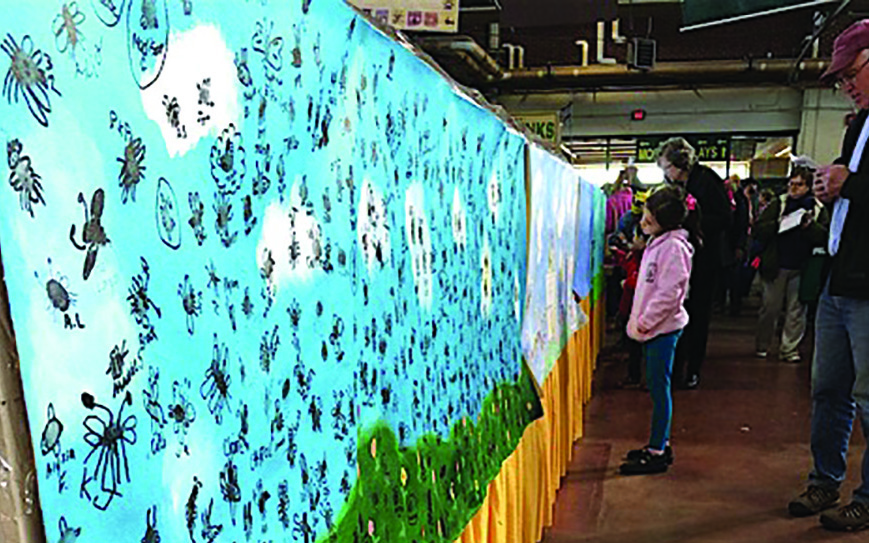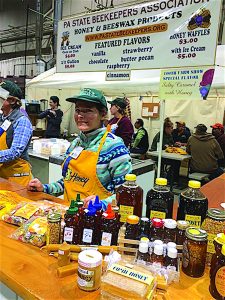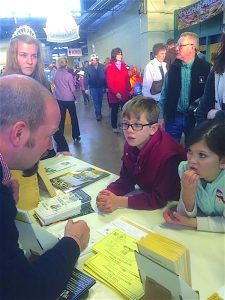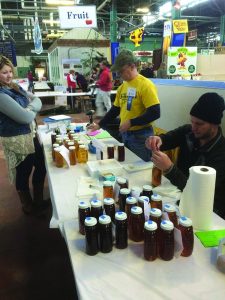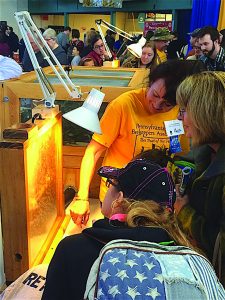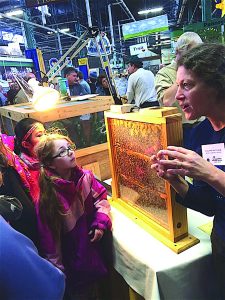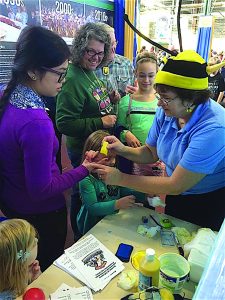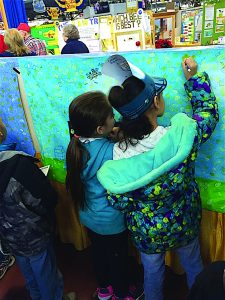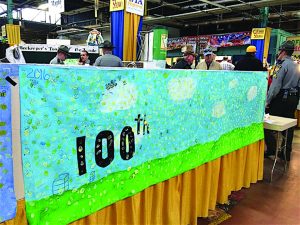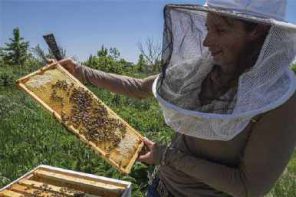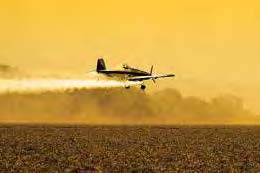The January 2016 Pennsylvania Farm Show was the 100th anniversary of this grand event. The PSBA does an outstanding job every year, and this was no exception. Because so many associations do ‘something’ at their fairs each year, we thought we would share what the PA people do each year that works so well for them. So take a look at their activities, and steal as many good ideas as you can. It works for them, and it will for you, too. Hats off to the PSBA for decades of success.
– Bee Culture Editors
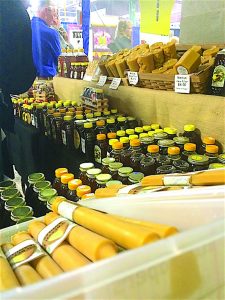 The Pennsylvania Farm Show held in January, is an event like none other. This year was the 100th anniversary of the first show, which began in 1917. Much has changed since the beginning, but one thing is for sure. With great volunteers and exhibits like those from the Pennsylvania State Beekeepers Association, the show will certainly keep visitors coming for a hundred more!
The Pennsylvania Farm Show held in January, is an event like none other. This year was the 100th anniversary of the first show, which began in 1917. Much has changed since the beginning, but one thing is for sure. With great volunteers and exhibits like those from the Pennsylvania State Beekeepers Association, the show will certainly keep visitors coming for a hundred more!
While just about every state hosts its state fair during the Summer or Fall, Pennsylvania waits until the most forgotten and underutilized time of the year to put on its premiere agricultural event, but it’s not in vain. The Pennsylvania Farm Show is the largest agricultural fair under roof in the United States. The 24-acre complex holds over 13,000 exhibits and 300 vendors, and attracts more than half a million visitors during its eight day run. It’s one of a kind, for sure! And each and every January, the Pennsylvania Farm Show Complex and Expo Center in Harrisburg becomes home base for the Pennsylvania State Beekeepers Association.
For those of you who aren’t familiar with the PSBA’s involvement at the Farm Show, allow me to explain. Throughout the complex, there are myriad activities happening at any given time. From commodities and animal judging to cooking demonstrations and sampling to live shows and contests and everything in between. Plus, there are hundreds of vendors and food booths, judged exhibits, animals on display, farming equipment, etc. Sprinkle in 75,000 people and quite literally it’s a zoo. But there is a method to the madness and the PSBA is well represented within the functional areas of the complex.
The Pennsylvania State Beekeepers Association sponsors three booths throughout the Farm Show. The first of these is the Learning Center, prominently located near the famous Butter Sculpture. This area includes a well-staffed booth of volunteers who stand near the dual observation hives, eagerly answering questions for the groups of children and adults alike who want to learn more about honey bees. These folks answer questions that range from, “Where is the queen?” or “How do they make honey?” to “Are bees still disappearing?” and “How do I become a beekeeper?” There are plenty of educational materials and handouts available to guide people in the right direction. It’s not uncommon to see the Pennsylvania Honey Queen spending time at this booth as well. 2016 PA Honey Queen Sarah McTish will spend this year educating the public about honey bees, and the Farm Show is one of her first big events. Of course, this area also includes all of the judged apiary exhibits- comb, extracted, and creamed honey; block and molded wax; candles; frames of honey; baked goods; mead and melomel; plus individual and county educational exhibits. In addition, this is the place where children can find a bee stamp to complete the Farm Show scavenger hunt. However, they don’t leave without adding their thumbprints to the annual bee collage. If you look up, you’ll see previous years’ canvases decorating the space above the exhibit.
The next booth is located in the Marketplace, just around the corner from the PA Preferred Culinary Connection Stage. This is the place to go for honey and beeswax. Each year, our members provide thousands of pounds of wholesale honey and beeswax to stock the booth. As people filter past, they are drawn to the booth, whether it’s to stock up on their favorite honey, or simply for a handful of honey sticks. The variety is astounding- black locust, wildflower, clover, goldenrod, Japanese knotweed, buckwheat, creamed, smoked, etc. There’s truly something for everyone. Most folks want to find a certain flavor, or they’re looking for a variety that’s local to them. The volunteers at the booth are knowledgeable and patient, helping each person find exactly what they’re looking for. This booth is a buzz of activity right up to the last moment. Of course, it’s even busier after the daily honey extraction demonstrations on the stage right around the corner.
A small group of dedicated volunteers gathers every day to host an informative honey extraction demonstration. Over the years, the crowds have grown, as everyone finds this demonstration to be exciting. After learning about the PSBA, honey bee biology, hive structure, and tools of the trade, visitors see the uncapping process, spinning, straining, and eventually get to taste the delicious final product. The question and answer session at the end gives visitors the opportunity to learn more about the process. But make sure to stay until the very last moment because you just might win a prize during trivia!
As the day passes, visitors are increasingly in need of refreshment. The PSBA sponsors a honey waffles and ice cream booth in the Food Court section of the Weis Expo Hall, all the way on the other side of the complex. The most common question our volunteers get here is invariably, “Oh, they’re all made with honey?” That’s right- each variety (Vanilla, Chocolate, Strawberry, Raspberry, Cinnamon, Butter Pecan, and Salted Caramel Pretzel) is sweetened with Pennsylvania honey to give it a unique flavor and creamy texture. There’s something special about handing a big softball-sized scoop of honey ice cream perched atop a cake cone to a wide-eyed visitor. Everybody loves it! Plus, the fresh-made hot waffles are sweetened with a generous amount of honey as well. Order a waffle with a variety of small scoops and then positively smother it with honey at the condiment bar. Visitors can also purchase a small variety of the honey and beeswax products that are available in the Marketplace, too. – Alyssa Fine
Honor Of A Lifetime
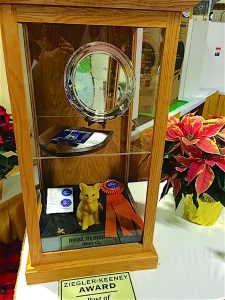
The renamed Ziegler-Keeney Award in tribute to Paul Ziegler and Dennis Kenney debuts in a magnificent case built by Dennis’ coworkers at the Farm Show. Winner is Ricky Freeman’s Molded or Designed Beeswax figure of a fox, chosen as Best of Show of the Best of Show in the classes of Beeswax, Extracted and Comb Honey.
Judged entries arrive on Thursday before the show. Before entries can be checked in, the tables need to be exactly where they need to be, just like a foundation. Then tables for dropping off entries and people assigned to specific products and check-in tasks. Check and re-check tags to paperwork. Sorting colors of honey is the toughest part. We did better using a digital pfund scale. But drawing 20° honey out of a container with a syringe to get a test sample has its challenges. So much gets done in the first few hours that I was shocked it was only lunch time, because it felt like a whole day’s work. To add more chaos, the butter sculpture becomes the center of a media blitz with reporters and cameras spilling into our exhibit area for the unveiling. Each county brings a truck-load of parts and people for their county’s exhibit and pretty soon it gets crazy. Honestly, it’s like ‘old home days,’ because the air is full of camaraderie and cooperation. Somehow, this is sounding like the inside of a hive. And somehow the chaos is orchestrated into order so that by 6:00 p.m. the day’s work is settled and done.
On Friday, exhibits are judged. Work begins by 9:00 a.m. In order to get so many different exhibits judged and judged fairly requires people able to discern the qualities of what they are evaluating. We had two judges specifically for honey and waxes. Two judges for baked goods. Two top quality winery owners judged Mead. The County and Individual Collective exhibits are first ‘fact-checked’ by the honey judges who are in the science of beekeeping. Then a team of the PA State FFA advisor and two officers individually score the collective exhibits. The FFA is disciplined in following specific criteria in many contests in which they compete. This team brings the public perspective of an older generation, a young man and a
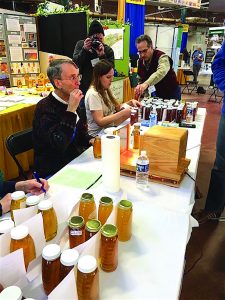
From top, Perry Arlia, brings more entries to judging table. Danica Fine records moisture content while judge, Bart Smith, scores for flavor, cleanliness, debris, fill and clarity.
young woman. They look for what draws their attention, how quickly the exhibit explains itself, balance, organization and educational value within the rules of the premium book. They bring their individual scores together, justify their reasons and settle on award placement. Each year, I ask the advisor how he feels about the outcome. Each year he can justify points that helped decide. The scores are often close, which reflects the quality on display.
This year, the Ziegler Award became the Ziegler-Keeney Award. The Ziegler Award was previously awarded at the PSBA annual meeting’s honey show. As the honey show lacked participation and available space, it was decided to bring this prestigious award to the Farm Show. Awarding it to the best of the ‘best of show’ in the classes of extracted honey, beeswax and comb honey. In April, the Farm Show agreed to provide or build a display case. After size considerations, I sent a pencil sketch with some basic dimensions. For those that don’t know, Dennis Keeney operated Ziegler honey by day and worked at the Farm Show by night. He passed away unexpectedly last year. His co-workers built this case and it shows the love and respect they had for Dennis. There was a lot of time, talk, wrangling and logistics at play. The engraved silver plate arrived only a week before the show. As fate would have it, a good friend of Dennis won the Ziegler-Keeney Award at the 100th Farm Show.
For this 100th Farm Show, Blue Ribbon Event, we ordered blue ribbons with “PA State Beekeepers Association”, keystone-bee logo and “100th Pa FARM SHOW” in gold lettering for all PSBA volunteers to attach to their name tags. Both a way to easily identify our group and a souvenir to take home. It also served to give us some idea how many volunteers help between the Learning Center, Honey Market and Food Court Honey Ice Cream. All 150 ribbons were used.
What turned out to be an attempt to be lucky enough to earn a ribbon signifying a part of history, turned out to be an Honor of a Lifetime.
I dusted off some of our molds, still left lost from a fire a couple years ago, to see if we could be lucky enough to earn a ribbon signifying the historical 100th Anniversary of the 2016 PA Farm Show. Competition can be very challenging and strong going up against the many talented beekeepers across the state including the respected excellence of Eugene Taylor and his family. After the birth of our son, we hadn’t competed for many years. Matter of fact the week our son was born, I helped Dennis with extracting that September. Our friendship has spanned many years.
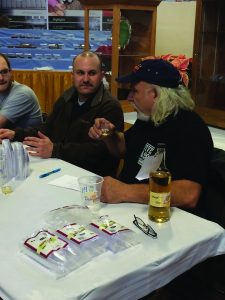
Mead judges – l) Jamie Williams of Wilcox Wineries and Bob Mazza of Mazza Wineries discuss qualities of this dry mead.
I have numerous fond memories of the many sleepless nights helping Dennis with pollination. Fun sleeping in a truck waiting for your pollination shift to start or grabbing a couple hours before going to your regular job after working on a pollination move. It is truly amazing how many hours straight he used to go at times. It just proved the caliber of strength that Dennis possessed and for the love of his craft. Sometimes it could be very tiring, but Dennis’s fun sense of humor and friendship made hard work easy and fun. We had a lot of amusing ways of keeping each other awake or working through equipment “malfunctions” including brakes, road curves and yes, stings. How many times have we been asked that question? Our nicknames of Dennis being “Spanky”, I being “Alfalfa” and Dan Schwartz being “Buckwheat” had given us a brotherhood of beekeepers practicing our love of beekeeping while helping farmers with their orchards and crops. Elaine, Julie, and Sandy would tease about their husbands spending nights together. Ruth Keeney had fondly become “Mom” and our son refers to her respectfully as “Grandma Ruth.” In later years as Brendin became older, there was a weekend when he helped with pollination. We laughed about the night Brendin fell asleep on Dennis’ shoulder coming back from a pollination job one early morning. We had many laughs over breakfast at Midway after a long night of moving bees. Dennis’ expertise taught us so much. We had the opportunity of getting to know and listen to the expertise of his uncle, Paul Ziegler; learning how to keep bees and how to do a good job with them especially their magical touch with queens. I could go on, with the caring, intelligent, knowledgeable and enjoyable ways that Paul and Dennis touched every one of us.
So the Ziegler-Keeney Award comes as a great honor at this year’s 2016 PA Farm Show. It TRULY has personal meaning. I thank the Ziegler and Keeney families and the PA State Beekeepers for making this award possible. I think Paul and Dennis are continuing their work making heaven beautiful and their voices can be heard. Look down on us beekeepers and give us wisdom so we, too, can make our heavenly earth beautiful and help these amazing creatures feed our world. And in closing I say “Thank you Spanky for touching my life once again. It has truly been a pleasure being a beekeeping brother, friend and “Rascal” with you”. ‘Till we meet again my friend… – Rick, Julie, and Brendin Freeman
Apiary Learning Center
The Apiary Learning Center again featured two observation hives that fed into a common atrium. The atrium is divided inside to prevent drifting. Jim Pinkerton, of Lancaster, provided both observation hives and keeps the atrium in the off-season. The backdrop to the Learning Station is made up of super-size honey bee photos. These high resolution photos were taken by Bill Mondjack, of Lehigh County. The photos are educational and a compliment to the PSBA Learning Station.
The Learning Center is where some volunteers are most comfortable. Teaching, talking and story telling at it’s best. It also allows some flexibility with manning the Honey Market and Food Court. Stan Poleshuk took on the task of scheduling volunteers. At least 2 per shift, from 8:00 a.m. to 9:00 p.m. Often times, more volunteers show up. That’s never a problem with so many visitors with so many questions. This is the place where we have the time to answer all those bee questions and give direction for new beekeepers.
A main attraction again this year was the observation hive, which as usual generated much interest and many questions. It is a pleasure watching young children excited to see a “queen”, listening to experienced beekeepers tell about their own beekeeping experiences, and answering questions from people curious about how honey bees live, work, collect pollen, make honey, raise new queens, and deal with things like mites and pesticides. My favorite questions are always “Is the queen born with a dot on her back?”, “How do beekeepers get the honey out?”, “Where can I buy honey?”, and “Which way is the honey extraction demo?” Quite a number of visitors this year expressed interest in possibly starting their own hives, and the PA State Beekeepers were ready with various informational materials to help them on their way.
The displays set up by beekeeper clubs and others were wonderful again this year and are a great success in providing visitors with information about every aspect of honeybees and beekeeping. Club members are to be truly commended for their originality, talent and time that went into educating the public and sharing their love of honey bees with others.
I can’t end this article without mentioning the enthusiastic and energetic worker bee with the antennae on her hat who each year fills a wall with Bee Thumbs big and small. Who’d have thought learning about bees could bee so much fun, even for us older folks who might not have acted like a kid for quite some time? – Diane Nacko
The thumbprint banner on the isle side of the honey-baked goods had many visitors. Often it was the ‘ice-breaker’ for a child. It’s a place to leave your mark, autograph or bit of bee-graffiti. The banner has become a ‘must stop.’ Cathy sometimes chases politicians or celebrities for the collection. With no state budget, very few politicians showed this year.
The 100th Pennsylvania Farm Show is now in the history books with record attendance. Many people visited the Farm Show Complex, with many also visiting the Honey/Apiary display. We started out with a blank eight- foot banner, with a blue sky background. The goal was to obtain 2016 thumbprints to fill the banner. Cathy started out by speaking to a State police officer who demonstrated the correct way to finger-print persons. [Place firmly and roll both ways for a complete fingerprint.]
After Saturday and Sunday- Cathy had collected about 650 thumbprints. She was very persistent in gathering thumbprints throughout the week. Many people of all ages and sizes stepped up to assist Cathy with meeting her goal of filling the banner with thumbprints. Secretary of Agriculture, Russell Redding, and his wife were volunteers, along with the State FFA Officer Team. Some people were also willing to assist in making the thumbprints into honeybees by adding two antenna, three body parts, four wings and six legs to their prints. We ended up with some pretty snazzy looking honey bees. Good news – and bad news – the banner was looking pretty well-filled, and people began adding prints to the other banners. Grand total of thumbprints was over 1800.
People have asked what we are doing with the banners that we have used in the past. Well, the past banners are displayed over the Apiary/Honey exhibit area. This activity has become a tradition with some Farm Show attendants. Several families were heard saying they have given their prints every year.
Our goal is to involve elementary schools to make banners showing their knowledge of bees/beekeeping for display each year. Kudos to Nate Webber for contacting Mountain View Elementary for this year’s banner. Special thank in advance to Eugene Taylor and Brad Dennis for volunteering to obtain completed banners for next year from local schools.
Also at the Education Station, maps were also being stamped for the Ag Explorer activity. This is an activity sponsored by Turkey Hill. Participants were asked to visit 15 of 34 stations at the Farm Show and get a stamp on the map. Before stamping, participants were asked to name something they knew about honey bees. They were then given an additional bit of information about bees. This station was also a drop-off point for completed maps and we were commended on turning in the largest amount of maps as any station.
Exhibits
[nggallery id=2]Even before set up was complete, exhibitors began assembling their displays and dropping off entries. What fun it was to talk with first time exhibitors who were excited, proud and yes somewhat nervous and apprehensive about submitting their entries. The many entries of honey, molded wax, baked goods and other food items, and (my favorite) mead and other apiary products were carefully unpacked, cataloged, graded, and arranged on display tables, ready for the judges the following day.
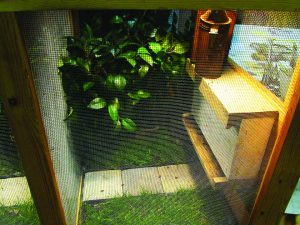 The Bees Are Back
The Bees Are Back
Well the bees are back from the Farm Show. Several people, both beekeepers and others asked, “How do you get the bees back in the hive”. In past years it has not been an issue. But this year the one hive, from the first day of the show, just seemed to not to have all the bees that were in there from the start. There were few dead in the “bee run” cage and they did not escape, but they were nowhere to be found! Well, when I got them home I found them. They were clustered in the decorative hive front that was in the caged area – probably about a pound of bees. I tried several ways to get them to go into the 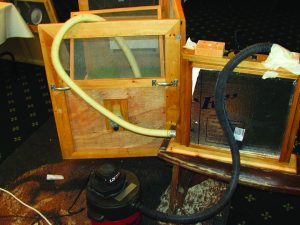 observation hive . . . in a cool room blew air on them with a fan, tried a mist of water “hey It’s raining go in”, left them set over night . . . nothing made them move, they just clustered a little tighter. So, I had to get creative. I taped the suction hose of a small shop vac in the feeding hole (it is screened so no bees would be sucked up), taped all holes shut and put a vacuum hose in the entrance. Make shift “bee vac”– the hive becomes the vacuum bag. All are now back in the hive and all is well. The small vac and the air leaks in the hive reduce the suction so no bees are hurt – just another windy day in the hive. – Jim Pinkerton
observation hive . . . in a cool room blew air on them with a fan, tried a mist of water “hey It’s raining go in”, left them set over night . . . nothing made them move, they just clustered a little tighter. So, I had to get creative. I taped the suction hose of a small shop vac in the feeding hole (it is screened so no bees would be sucked up), taped all holes shut and put a vacuum hose in the entrance. Make shift “bee vac”– the hive becomes the vacuum bag. All are now back in the hive and all is well. The small vac and the air leaks in the hive reduce the suction so no bees are hurt – just another windy day in the hive. – Jim Pinkerton
A “Thank You” to Mann Lake bee supply for donating over $1,500 worth of equipment for the Learning Station and Honey Extraction Demonstrations. Mann Lake employees also helped with setup and showed up several days to help scoop ice cream at the Food Court.
A big thank you also to the PA folks that helped us put this article together by furnishing all of the photos and the information – Charlie and Cathy Vorisek, Ronda Fawber, Debbie Morse, Alyssa Fine, Jim Pinkerton, Diane Nanko.







